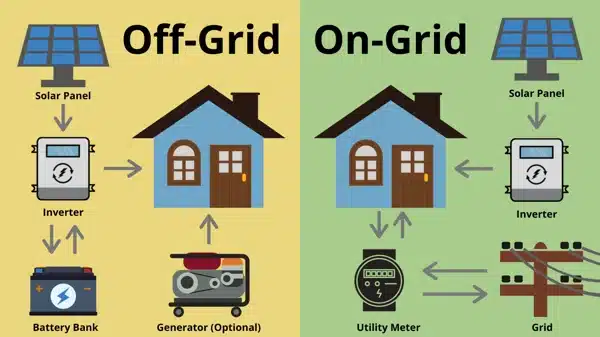Solar Inverters: When diving into solar energy, one of the most critical components you’ll come across is the solar inverter—the device responsible for converting the direct current (DC) from your solar panels into alternating current (AC) that powers your home or business. But not all inverters are the same. The two main types—grid-tied and off-grid inverters—serve very different purposes.
In this post, we’ll break down the key differences, benefits, and ideal use cases of grid-tied and off-grid inverters to help you decide which one is right for your solar energy system.

⚡ What Is a Grid-Tied Solar Inverters?
A grid-tied inverter is connected to both your solar panels and the public electricity grid. This type of system is designed for areas with a reliable power supply and is the most common setup for residential and commercial users.
✅ Benefits of Grid-Tied Inverters:
- Net Metering: Excess power generated can be sent to the grid, often earning you credits on your utility bill.
- Lower Costs: You don’t need to invest in batteries, making initial installation cheaper.
- High Efficiency: These inverters are optimized to work with the grid, ensuring minimal power loss.
🚫 Limitations:
- No Backup During Outages: If the grid goes down, your system shuts off too—for safety reasons.
- Dependency on Utility Grid: You’ll still rely on the grid at night or during cloudy periods.
🌐 What Is an Off-Grid Solar Inverters?
An off-grid inverter operates independently of the utility grid. It works alongside a battery bank, storing energy for use at night or when the sun isn’t shining. This system is ideal for remote areas or users who want complete energy independence.
✅ Benefits of Off-Grid Inverters:
- Total Energy Independence: Perfect for cabins, rural properties, or areas with unreliable grid access.
- Backup Power: With sufficient battery storage, you won’t lose power during outages.
- Sustainable Living: Encourages conscious energy consumption and self-reliance.
🚫 Limitations:
- Higher Initial Cost: Batteries and other components make it more expensive upfront.
- Complex Maintenance: Managing batteries and charge levels requires more attention.
- Limited Energy Supply: You’re restricted by how much energy your system can store.
🆚 Grid-Tied vs Off-Grid: Quick Comparison Table
| Feature | Grid-Tied Inverter | Off-Grid Inverter |
|---|---|---|
| Connection to Utility | Yes | No |
| Battery Required | No | Yes |
| Works During Outages | No | Yes (with battery backup) |
| Cost | Lower initial cost | Higher upfront investment |
| Ideal For | Homes in cities/suburbs | Remote or rural locations |
| Maintenance | Low | Moderate to high |
🔍 Which One Should You Choose?
- Choose a grid-tied inverter if you live in an area with reliable electricity and want to reduce your utility bills with solar power.
- Choose an off-grid inverter if you’re in a remote area, want full energy independence, or are preparing for long-term self-sufficiency.
You can also explore hybrid inverters, which combine the best of both worlds—connecting to the grid while also supporting batteries.
❓ Frequently Asked Questions (FAQs)
Q1: Can I use a grid-tied inverter with batteries?
A: Not directly. Grid-tied inverters aren’t designed to work with batteries. If you want storage, consider a hybrid inverter that supports both grid connection and battery backup.
Q2: What happens during a power outage with a grid-tied system?
A: Your solar system will automatically shut down during a grid outage to protect utility workers from backfeeding electricity. If you want backup power, you’ll need an off-grid or hybrid system.
Q3: Are off-grid systems more expensive to install?
A: Yes. Off-grid systems require batteries, charge controllers, and sometimes generators, which increase the initial setup cost.
Q4: Can I start with a grid-tied system and go off-grid later?
A: It’s possible but not always straightforward. You’ll likely need to replace or upgrade your inverter and add batteries. Planning ahead with a hybrid system gives more flexibility.
Q5: Which type of inverter is better for commercial use?
A: For most commercial buildings connected to the grid, grid-tied systems are more cost-effective. However, off-grid or hybrid setups might be better for critical infrastructure or remote facilities.
Final Thoughts
Choosing between grid-tied and off-grid inverters depends on your location, energy needs, budget, and goals. Whether you’re looking to save on your electric bill or cut ties with the grid entirely, understanding these inverter types is key to building an efficient and reliable solar power system.
